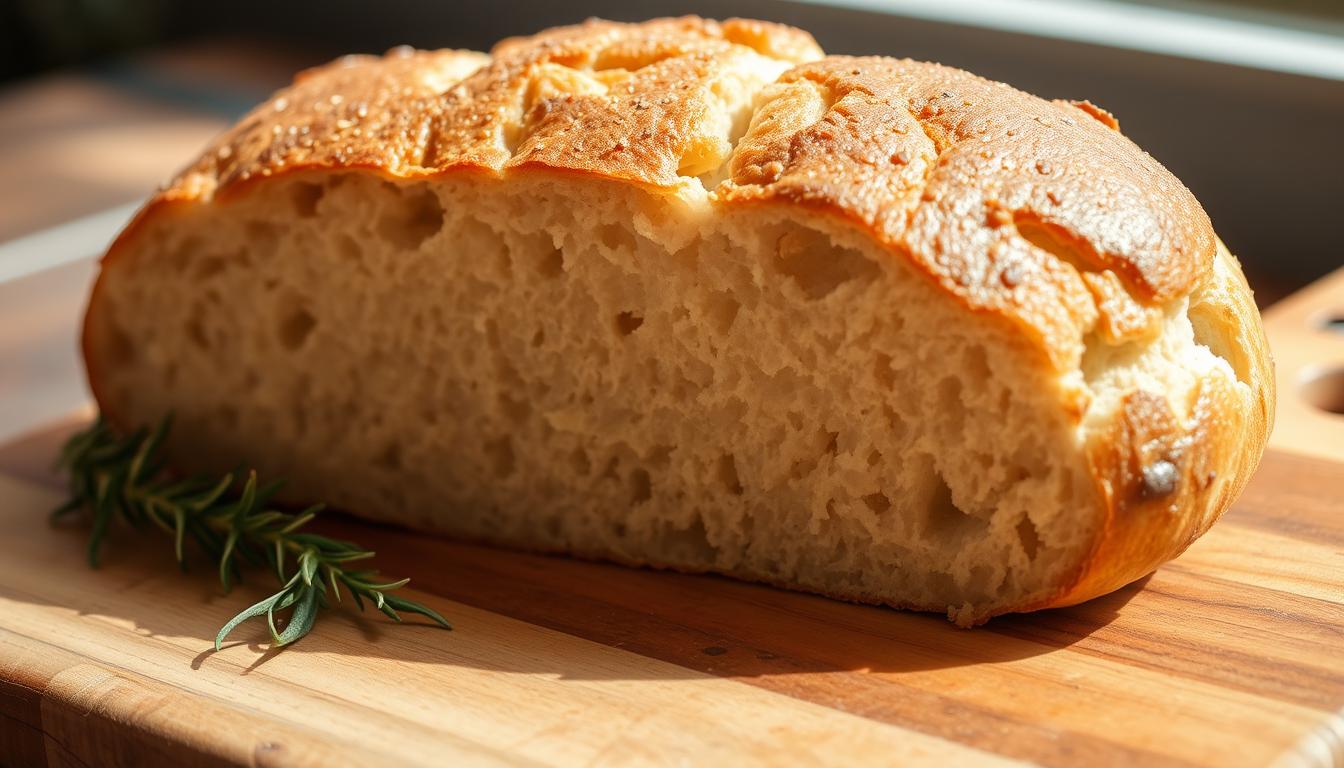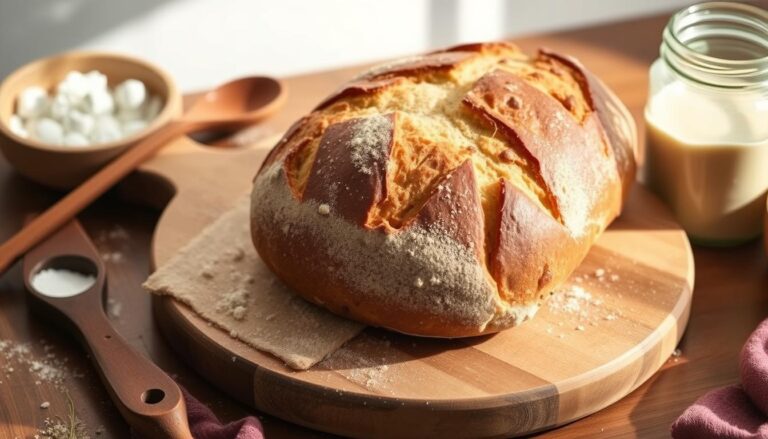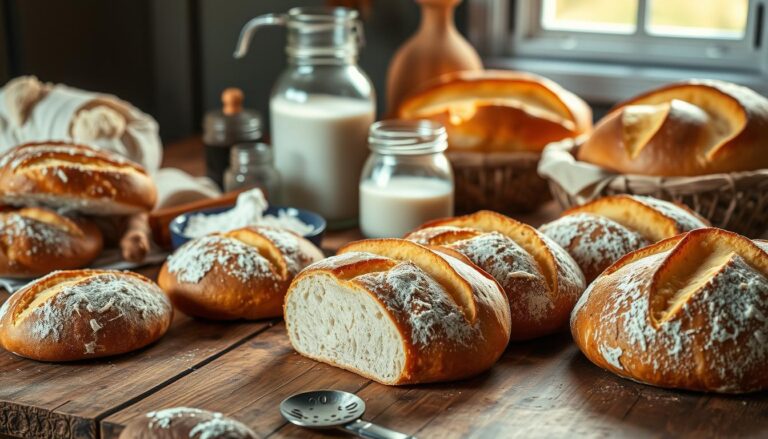Best Sourdough Bread for Stuffing (Choosing the Right Loaf)
The moment you pull that golden, herb-scented stuffing from the oven might be the highlight of your holiday meal. That perfect balance of crispy edges and tender middle creates memories that last long after the dishes are cleared. While many traditional recipes call for standard white bread, sourdough bread for stuffing has been gaining devoted fans for good reason.

What makes sourdough special? Its distinctive tang and sturdy texture transform ordinary stuffing into something extraordinary. The natural fermentation process creates a bread that holds its structure when mixed with broth and seasonings, avoiding the dreaded mushy outcome that disappoints so many home cooks.
Not all loaves are created equal when it comes to sourdough stuffing. The density, crust type, and even the age of your bread can dramatically impact your final dish. Selecting the right loaf might seem simple, but it’s actually the foundation of stuffing success.
In this guide, you’ll discover exactly what to look for when choosing sourdough for your holiday side dish. We’ll explore how different varieties affect texture, which flavor profiles complement traditional stuffing herbs, and the best preparation methods to ensure your sourdough stuffing becomes the talk of the table.
Table of Contents
Why Sourdough Bread Makes Exceptional Stuffing
Choosing sourdough bread for your stuffing is more than a trend. It’s a choice that boosts flavor and texture. Many ask, can you make stuffing with sourdough bread? Yes, and it makes your stuffing stand out with its unique taste.
The Unique Flavor Profile of Sourdough
Sourdough bread has a tangy flavor that regular bread can’t match. This comes from wild yeasts and bacteria that ferment the dough.
These acids give sourdough its tangy taste. This taste complements the richness of butter and broth. It also brings out the earthy flavors of herbs, onions, and celery.
Using sourdough stuffing adds a depth of flavor. It turns a simple side dish into something special. The tanginess of sourdough balances the flavors better than white bread.
Structural Advantages for Stuffing Recipes
Sourdough bread is great for stuffing because of its texture. It stays firm even when wet, keeping its shape while soaking up flavors.
The fermentation process strengthens the gluten. This keeps the bread from falling apart when mixed with liquids. Your stuffing stays hearty but still has a nice texture.
The crust of sourdough adds a nice crunch. Toasting it for stuffing creates crunchy bits on top. It also keeps the stuffing dense and satisfying.
Nutritional Benefits Compared to Regular Bread
Sourdough is not just better tasting; it’s also healthier. The fermentation process makes minerals easier for your body to use.
Many find sourdough easier to digest than regular bread. The long fermentation time breaks down gluten and starches. This makes it better for those with mild gluten sensitivities.
| Nutritional Aspect | Sourdough Bread | Regular White Bread | Whole Wheat Bread |
|---|---|---|---|
| Glycemic Index | Lower (slower blood sugar impact) | Higher | Moderate |
| Prebiotic Content | Higher (feeds beneficial gut bacteria) | Lower | Moderate |
| Mineral Availability | Enhanced through fermentation | Lower | Moderate but limited by phytic acid |
| Digestibility | Improved through pre-digestion | Standard | Can be harder to digest |
While stuffing isn’t healthy, sourdough adds nutritional value. It has a lower glycemic index. This means it won’t raise blood sugar as much as white bread.
Selecting the Best Sourdough Bread for Stuffing
Choosing the right sourdough bread is key for a great holiday stuffing. The bread’s texture and flavor are crucial. The wrong bread can make your stuffing soggy or taste off.
Ideal Crust Thickness
The crust of your sourdough is important for stuffing texture. Choose bread with a medium-thick crust for the best results. It should be golden and firm but not too hard.
Too thick crusts can make your stuffing tough. Thin crusts might disappear in the oven. The perfect crust is firm but softens when pressed.
Crumb Structure and Density
Look at the bread’s inside when picking sourdough for stuffing. A medium-tight crumb is best. Bread with big holes can make stuffing uneven.
The best sourdough has a uniform inside with small holes. This helps it soak up liquid evenly. It keeps your stuffing from becoming mushy.
Moisture Content Considerations
Fresh sourdough is too wet for stuffing. The best bread should feel slightly dry but not hard.
Check the bread’s moisture by squeezing it gently. It should feel firm but not too soft. Too wet bread can make stuffing soggy. Too dry bread might need more liquid.
Artisan vs. Commercial Sourdough Options
Artisan sourdough often tastes better, but commercial bread might be better for stuffing. Artisan loaves have open crumb and thick crusts, which can be hard to work with.
Commercial breads have finer crumb and better liquid absorption. Choose bread that’s right for stuffing, not just for taste. The best stuffing comes from bread with the right texture, not just flavor.
If you want artisan sourdough, look for tighter crumb. Some bakeries make “sandwich loaves” that are perfect for stuffing.
Fresh vs. Stale: The Age Factor in Sourdough Stuffing
Creating great sourdough stuffing is all about the bread’s age and how it absorbs liquid. You might think the freshest bread is best, but aged bread is actually better. The right sourdough bread for stuffing absorbs broth and butter well, thanks to its moisture and structure.
Why Day-Old Sourdough Works Best
Fresh sourdough is too moist to soak up liquids well. This can make your stuffing soggy and lose its texture.
Day-old sourdough, however, is perfect. It’s lost some moisture but still holds its shape. This makes it great for soaking up flavors without falling apart.
As sourdough ages, its tangy flavor gets even better. This adds depth to your stuffing, making it stand out from regular bread.
How to Properly Age Your Bread for Stuffing
To prepare sourdough, cut it into pieces and let it dry naturally. Place the pieces on a wire rack or baking sheet. Leave them uncovered at room temperature overnight. This makes the bread just right for stuffing.
If you’re in a hurry, use a low oven (around 250°F). Spread the bread cubes in a single layer and bake for 15-20 minutes. Stir occasionally until they’re dry but not hard.
The bread is ready when it’s firm but still soft in the middle. It should not be too moist or too hard.
Rescuing Bread That’s Too Fresh or Too Stale
If your sourdough is too fresh, you can dry it faster. Cut it into smaller pieces and dry in a 225°F oven for 30-40 minutes. Stir occasionally to speed up the drying.
If your bread is too hard, you can still use it. Mist it with water lightly before mixing with your stuffing. This softens the crust without making it too wet. Let it rest for 5-10 minutes before cooking.
The bread’s texture before cooking is key to your stuffing’s success. Aim for a balance where the bread absorbs liquid but doesn’t crumble. This ensures your sourdough bread for stuffing stays delicious throughout cooking.
Types of Sourdough Bread and Their Impact on Stuffing
Exploring sourdough bread types shows how each can change your stuffing’s taste and texture. Each sourdough has a unique flavor, making your stuffing unforgettable. Let’s explore how different sourdoughs can enhance your holiday stuffing.

Classic San Francisco Sourdough
San Francisco sourdough is a top choice in American bread. It has a tangy taste and chewy inside. This bread is great for traditional stuffings, adding a nice acidity.
The sour taste goes well with herbs like sage and thyme. But, very sour breads can overpower other flavors in your stuffing.
Boudin Bakery’s San Francisco sourdough is perfect for stuffing. It’s been around for over 170 years. Its texture holds up well, even when moist.
Whole Wheat and Multigrain Sourdough Options
Whole wheat and multigrain sourdoughs add nutrition and earthy flavors. They soak up less liquid than white bread, so you might need to adjust the recipe.
The nutty taste of whole grain sourdough is great for stuffings with mushrooms and nuts. Add about 15% more liquid to keep it moist.
Multigrain breads with seeds like flax add texture. They’re perfect for vegetarian stuffings, adding richness without meat.
Specialty Sourdough Varieties (Olive, Herb, Rye)
Flavored sourdoughs offer exciting stuffing options. Olive sourdough adds a Mediterranean twist, pairing well with fennel and citrus.
Herb-infused sourdoughs like rosemary or garlic reduce the need for extra seasonings. Rye sourdough, with its caraway notes, is great for game meat stuffings.
When using these breads, think about how their flavors will mix with your stuffing. Aim for harmony, not competition.
Regional Sourdough Variations
There are many regional sourdoughs, each with its own taste. Eastern European sourdoughs are milder, perfect for traditional recipes.
Pacific Northwest sourdoughs use local grains like emmer, creating unique stuffings. Southern-style sourdoughs are less sour, ideal for cornbread-sourdough hybrid stuffings.
Pairing regional sourdoughs with local ingredients makes your holiday dishes authentic. A Vermont sourdough with maple syrup is different from a Texas sourdough with pecans.
| Sourdough Type | Flavor Profile | Best Stuffing Applications | Liquid Absorption | Special Considerations |
|---|---|---|---|---|
| Classic San Francisco | Pronounced tang, chewy texture | Traditional herb stuffings | Medium-high | May need flavor balancing if very sour |
| Whole Wheat | Nutty, earthy, less sour | Mushroom and wild rice stuffings | Medium | Requires 10-15% more liquid |
| Olive Sourdough | Briny, Mediterranean | Mediterranean-inspired stuffings | Medium-high | Reduce added salt in recipe |
| Rye Sourdough | Earthy, caraway notes | Game meat stuffings | Medium-low | Pairs well with dried fruits |
| Regional Varieties | Varies by region | Regional holiday recipes | Varies | Match with local ingredients |
Preparing Sourdough Bread for Stuffing
Turning sourdough bread into stuffing is a journey. It needs careful preparation to get the right tang and texture. By doing it right, your stuffing will be moist and tasty in every bite.
Cutting Techniques: Cubes vs. Torn Pieces
Choosing how to cut your sourdough is key. Precisely cut cubes make your stuffing look elegant and have a consistent feel. Aim for cubes between ¾ and 1½ inches for the best mix of softness and firmness.
On the other hand, torn pieces give your stuffing a homemade look with more texture. The uneven edges of torn bread make your stuffing crispy in spots. This adds a nice contrast to the soft inside.
Whether to use cubes or torn pieces depends on your taste and the meal’s style. Cubes are great for formal dinners, while torn pieces are perfect for cozy gatherings.
Drying Methods for Perfect Texture
Drying your bread right is crucial for great stuffing. Fresh sourdough is too wet and will get soggy with broth. Here are ways to dry it just right:
- Natural air-drying: Spread bread on baking sheets and let it air dry at room temperature for 1-2 days, stirring now and then
- Oven-drying: Lay bread flat and bake at 225°F for 30-40 minutes, flipping halfway
- Combination method: Air-dry overnight, then oven-dry briefly for consistent results
Look for bread that’s dry to the touch but still a bit moist inside. It should soak up broth well without getting too hard.
Pre-toasting Techniques
Pre-toasting your sourdough before mixing it with wet ingredients is a big plus. A quick toast at 350°F for 10-15 minutes makes the bread golden and enhances flavors.
This step also helps prevent sogginess by creating a barrier against moisture. Toasting makes whole wheat or multigrain sourdough even tastier, adding depth to your stuffing.
But don’t overdo it. Too much browning can make the bread bitter. Aim for a light golden color without getting too dark.
Proper Storage of Prepared Bread
If you’re making your bread ahead of time, storing it right is key. Let it cool completely after drying or toasting to avoid moisture. This keeps it fresh until you’re ready to make your stuffing.
Store dried bread cubes in paper bags for better air flow. For longer storage, use airtight containers with a paper towel to soak up any extra moisture.
Keep your bread in a cool, dry place, not the fridge. If it starts to soften, just warm it up in a 250°F oven for a few minutes. This will get it back to perfect for your stuffing.
Flavor Pairings: Ingredients That Complement Sourdough Stuffing
Making the perfect sourdough stuffing is all about choosing the right ingredients. The sourdough’s tangy taste is a great base. Adding the right mix of flavors can make your stuffing truly special.
Herbs and Aromatics
Sage is a classic choice that pairs well with sourdough. It adds an earthy flavor that balances out the tang. Other herbs like thyme, rosemary, and parsley also complement the bread’s taste.
For aromatics, consider these standout options:
- Caramelized onions – their sweetness counters sourdough’s tang
- Leeks – milder than onions with a buttery quality when cooked
- Shallots – offering a refined flavor that doesn’t overpower
- Fennel – providing a subtle anise note that adds dimension
Let these aromatics cook slowly until they’re soft and fragrant. This brings out their full flavor.
Fruits and Nuts
Fruits add sweetness and moisture to sourdough. Dried cranberries and apples bring tartness and freshness. Dried apricots and cherries add bursts of flavor.
Nuts add texture and richness. Toast them before adding to enhance their taste:
- Pecans – buttery and slightly sweet
- Walnuts – earthy with pleasant bitterness
- Hazelnuts – distinctly aromatic and rich
- Chestnuts – uniquely sweet and meaty
Meats and Savory Additions
Sourdough’s tang cuts through richness and complements savory flavors. This makes it perfect for various proteins in your stuffing.
Italian sausage with fennel seeds is a classic choice. Chorizo adds smoky heat. Bacon brings saltiness and umami. Oysters add briny complexity for a coastal twist.
Mushrooms are great for their meaty texture and earthy flavor. Wild varieties like porcini or chanterelles pair well with sourdough.
Regional and Seasonal Variations
Your sourdough stuffing can reflect different traditions and seasons. Mediterranean versions might include olives and sun-dried tomatoes. New England versions might have cranberries and maple-glazed bacon. Southern versions might feature pecans and cornbread.
Seasonal produce can change your stuffing throughout the year:
| Season | Featured Ingredients | Complementary Herbs | Texture Elements |
|---|---|---|---|
| Fall | Butternut squash, apples | Sage, thyme | Toasted pecans, dried cranberries |
| Winter | Mushrooms, leeks | Rosemary, bay leaf | Chestnuts, bacon |
| Spring | Asparagus, peas | Chives, tarragon | Almonds, lemon zest |
| Summer | Cherry tomatoes, corn | Basil, oregano | Pine nuts, pancetta |
Remember, sourdough’s unique flavor means you might not need as much salt. Its natural fermentation process adds enough complexity, so you can use less seasoning than with regular bread.
Classic Homemade Sourdough Stuffing Recipe
Learn to make homemade sourdough stuffing with our trusted recipe. It brings out the best in this artisanal bread. Yes, you absolutely can make stuffing with sourdough bread. Many chefs love it for its texture and taste.
Ingredients and Equipment
Quality ingredients are key to great homemade sourdough stuffing. The bread should be top-notch.
- 1 large loaf (about 1 pound) day-old sourdough bread
- 4 tablespoons unsalted butter, plus more for greasing
- 2 medium onions, diced (about 2 cups)
- 3 celery stalks, diced (about 1 cup)
- 3 cloves garlic, minced
- ¼ cup fresh parsley, chopped
- 1 tablespoon fresh sage, minced
- 1 tablespoon fresh thyme leaves
- 1 tablespoon fresh rosemary, minced
- 2-3 cups chicken or vegetable stock (preferably homemade)
- 2 large eggs, beaten
- Salt and freshly ground pepper to taste
You’ll need a large mixing bowl, sharp knife, cutting board, skillet, and a 9×13-inch baking dish.
Step-by-Step Preparation
Creating perfect homemade sourdough stuffing needs careful attention at each step.
- Cut or tear your sourdough bread into 1-inch cubes. Spread them on baking sheets and let them dry overnight, or toast in a 250°F oven for 30-45 minutes until dry but not browned.
- Preheat your oven to 350°F and butter your baking dish.
- In a large skillet, melt butter over medium heat. Add onions and celery, cooking until softened (about 8 minutes).
- Add garlic and cook for another minute until fragrant.
- In your large mixing bowl, combine dried bread cubes, sautéed vegetables, and all herbs.
- Pour in 2 cups of stock and the beaten eggs, tossing gently to combine. The mixture should be moist but not soggy. Add more stock if needed.
- Season generously with salt and pepper, tasting to adjust (if comfortable with raw egg).
- Transfer to your prepared baking dish, spreading evenly.
Cooking Methods and Timing
The cooking method affects your sourdough stuffing’s texture. Choose based on your preference:
| Cooking Method | Temperature | Timing | Texture Result | Best For |
|---|---|---|---|---|
| Covered Baking | 350°F | 30 minutes covered, 15 minutes uncovered | Moist interior, lightly crisp top | Traditional stuffing lovers |
| Uncovered Baking | 350°F | 40-45 minutes | Crispy top and edges, drier interior | Those who prefer texture contrast |
| In-Bird Stuffing | Follows turkey temperature | Varies with bird size | Very moist, flavor-infused | Traditional presentation |
| Slow Cooker | Low setting | 3-4 hours | Uniformly moist throughout | Freeing oven space |
The covered-then-uncovered method is often best for sourdough stuffing. It lets the bread absorb flavors and get a nice crust. Always check the center reaches 165°F for safety.
Make-Ahead and Storage Tips
Make homemade sourdough stuffing ahead to ease holiday cooking stress. Prepare up to the baking stage, cover tightly, and refrigerate for up to 24 hours.
When ready to bake, remove from the fridge 30 minutes before. Add an extra ¼ cup of stock if it’s dry. Increase covered baking time by 10-15 minutes if starting cold.
Leftover stuffing stays good in an airtight container in the fridge for up to 3 days. For the best reheating results, sprinkle with a little stock or water. Cover with foil and warm in a 325°F oven until heated through (about 20 minutes). Remove foil for the last 5 minutes to crisp the top.
Sourdough stuffing can also be frozen for up to 1 month. Thaw overnight in the fridge before reheating as above.
Boudin Sourdough Stuffing: A San Francisco Tradition
Boudin sourdough stuffing is a big deal in San Francisco. It turns the famous bread into a holiday star. This dish connects Bay Area families through their love of local flavors.
History of Boudin Bakery Sourdough
Boudin Bakery started in 1849 during the Gold Rush. It’s San Francisco’s oldest business still open. The bakery is famous for its original mother dough, a sourdough starter over 170 years old.
This starter, named “Isidore,” has wild yeasts found only in San Francisco. It gives the sourdough its tangy taste.
The sourdough is known for its chewy inside and crispy outside. Miners called it “French bread” during the Gold Rush. But its unique taste comes from San Francisco’s special bacteria.

Authentic Boudin Sourdough Stuffing Recipe
The Boudin sourdough stuffing recipe is a holiday must-have. Here’s how to make it at home:
| Ingredients | Quantity | Preparation Notes |
|---|---|---|
| Boudin sourdough bread | 1 large loaf (about 1 pound) | Cut into 1-inch cubes, dried overnight |
| Yellow onion | 1 large | Finely diced |
| Celery | 3 stalks | Finely diced |
| Unsalted butter | ½ cup | Divided |
| Fresh herbs (sage, thyme, rosemary) | ¼ cup total | Finely chopped |
Start by sautéing onions and celery in butter until they’re soft. Add herbs and cook until they smell good. Then, mix bread cubes with the vegetables.
Add warm chicken broth a little at a time until the bread is moist but not wet. Season with salt and pepper. Put it in a buttered dish and bake at 350°F for 35-40 minutes until it’s golden brown.
Tips for Recreating the Boudin Experience at Home
If you can’t get Boudin bread, you can still make a similar dish. Look for sourdough with a strong tang and open crumb. It should have a thick crust and chewy inside.
To make any bread taste like sourdough, try these tips:
1. Add a tablespoon of sourdough starter to your stuffing if you have it.
2. Use a splash of white vinegar for the tanginess.
3. Toast your bread cubes well to bring out flavors.
4. Use water rich in minerals to mimic San Francisco’s water.
Variations on the Classic Recipe
The Bay Area’s food scene has inspired many Boudin sourdough stuffing variations:
TheFisherman’s Wharf version adds fresh Dungeness crab. Use 1 pound of lump crabmeat before baking.
The Wine Country adaptation includes ½ cup of dry white wine from Napa or Sonoma. Add dried cranberries and toasted walnuts for a fruity, nutty taste.
The Forager’s Variation celebrates Northern California’s mushrooms. Use 1 pound of sautéed wild mushrooms like chanterelles or porcini for an earthy flavor.
Each version keeps the Boudin sourdough’s essence while showing off the Bay Area’s culinary diversity. This stuffing is more than a side dish; it’s a celebration of San Francisco’s rich food heritage.
Conclusion: Elevating Your Holiday Meals with Sourdough Stuffing
Choosing the right bread is the first step to making amazing stuffing. Sourdough is a top pick for its unique taste and firm texture. This guide has shown how sourdough bread makes stuffing stand out.
Yes, you can make stuffing with sourdough bread, and it will make your holiday meals special. Sourdough’s special flavor and texture soak up broth and seasonings well. It adds depth to your stuffing, no matter the type.
Getting your stuffing right starts with day-old bread, dried or toasted. The way you cut the bread affects the stuffing’s texture. You can choose neat cubes or torn pieces, depending on what you like.
Sourdough stuffing isn’t just for Thanksgiving. It goes well with roasted chicken, pork loin, or as a vegetarian main dish. The recipes and tips here are just the beginning of your creative journey.
At your holiday table, sourdough stuffing is more than just food. It’s a conversation starter, a new tradition, and a flavor experience your guests will remember. It’s a highlight of the season.
FAQ
Why is sourdough bread better for stuffing than regular bread?
Sourdough bread is great for stuffing because it has a tangy flavor. This flavor complements the stuffing’s ingredients well. The bread’s texture also holds up to moisture, keeping it from getting soggy.Its gluten helps it stay together when mixed with liquid. This makes the stuffing more enjoyable to eat.
How do I choose the best sourdough bread for stuffing?
Look for sourdough with a medium crust. It should be golden-brown and not too thick. This adds structure without being too chewy.Choose bread with a medium-tight crumb. This helps it absorb liquid evenly. The bread should be slightly dense but not too compact.
Should I use fresh or stale sourdough bread for stuffing?
Use day-old sourdough for the best results. Fresh bread is too moist and can become soggy. Stale bread is perfect for absorbing flavors without falling apart.To dry fresh bread, let it sit out overnight. Or, dry it in a low-temperature oven (250°F) for 30-45 minutes.
What’s the difference between using cubed versus torn sourdough for stuffing?
Cubed bread makes a uniform stuffing. Torn bread adds texture and rustic appeal. Cubes absorb liquid evenly, while torn pieces brown better.Choose based on your preference for texture and look.
Which herbs and ingredients pair best with sourdough stuffing?
Sourdough’s tanginess goes well with herbs like sage and thyme. Aromatics like leeks and shallots enhance the flavor. For sweetness, add dried cranberries or apples.Sausages, bacon, and mushrooms work well too. The tangy bread balances their richness.
Can I make sourdough stuffing ahead of time?
Yes, you can prepare sourdough stuffing ahead. Dry bread cubes up to a week in advance. Or, assemble the stuffing up to 24 hours before baking.For longer storage, freeze unbaked or baked stuffing for up to 1 month.
What’s special about Boudin sourdough stuffing?
Boudin sourdough stuffing is a San Francisco tradition. It uses Boudin Bakery’s sourdough, known for its tangy flavor. This bread pairs well with stuffing ingredients.The authentic Boudin experience offers a unique balance of tanginess and savory flavors.
How do I prevent sourdough stuffing from becoming too soggy or too dry?
Dry bread properly before mixing with wet ingredients. Lightly toasting the bread cubes helps prevent sogginess. For dryness, add warm broth gradually until it’s just right.Cover the stuffing with foil to keep it moist, then uncover for a crispy top.
Can you make stuffing with whole wheat or multigrain sourdough?
Yes, whole wheat and multigrain sourdough are great for stuffing. They add nutritional value and a rustic flavor. These breads may need more liquid and longer soaking time.They pair well with wild mushrooms, dried fruits, and herbs like thyme and sage. They make a robust stuffing for strong flavors.
What are the nutritional benefits of using sourdough bread in stuffing?
Sourdough’s fermentation process makes nutrients more accessible. It’s easier to digest than regular bread. The fermentation breaks down phytic acid, improving mineral absorption.Sourdough has a lower glycemic index, causing a slower rise in blood sugar. It also has probiotic qualities from the beneficial bacteria. This makes sourdough stuffing a healthier option.







